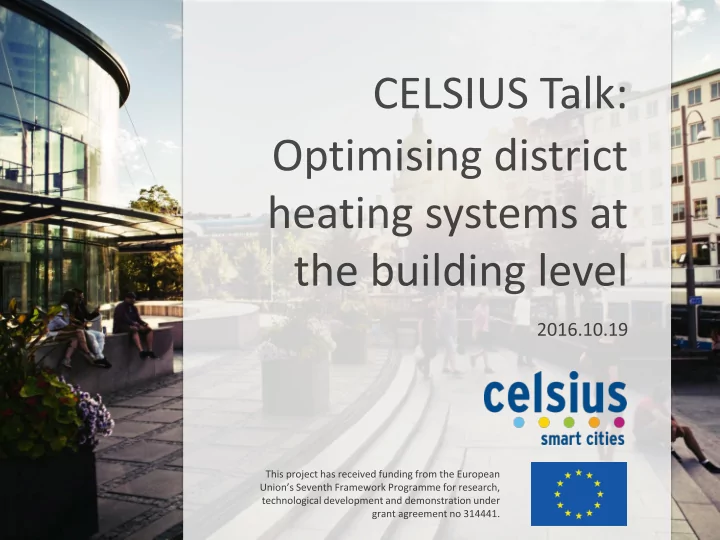

Agenda Background and purpose with study • Data collection • Results radiator temperatures • Results factors affecting the temperatures • Conclusion • 3
Background Future Expectations Situation Today • 3 rd generation • Decrease of building heat demand • 90-75°C Supply / 40-50°C Return • New heat sources to be integrated • Customer temperature demand: • Improve environmental 20°C space heating / 50-60°C DHW performance Low temperature district heating (LTDH) 50-55°C Supply 20-30°C Return 4
Background Radiators in Buildings Previous Work • Focus on temperatures on the district • Design before 1980: typ. 80°C supply heating side • Design after 1982: max 60°C supply • Lack of documentation of temperatures on secondary side • Control, monitoring and balancing of radiator systems important What are the temperatures of radiator systems in existing buildings? 5
The Actors Involved in This Project District Heating Provider Public Housing Company • Major DH customer • 330 Substations • 26 900 Apartments • Hourly data measurements Research Institution available from SCADA system 10/19/2016 Chalmers Teknologkonsulter AB 6
Data Collection Temperature data from: 5 different geographical areas within • Gothenburg district heating system Multi-family buildings only • February 1st 2015 to January 31st 2016 • 109 radiator systems in total • Recorded automatically in the substation of • each radiator system Each radiator system serves • approx. 100 apartments District Heating Substation 10/19/2016 Chalmers Teknologkonsulter AB 7
Radiator Supply Temperatures 90 Radiator Supply Temperature For DOT = - 16˚C [°C] 80 Avg: 64°C • 70 Max: 81°C Min: 53°C 60 Outliers (circled) • almost 4˚C higher than control curve 50 set points 40 9 radiator systems • (8%) have supply temperatures of 30 55˚C or less 20 10 0 -16°C -10°C -5°C 0°C 5°C 10°C 15°C Outdoor Temperature Design Outdoor Temperature Building Balance Temperature (DOT) 10/19/2016 Chalmers Teknologkonsulter AB 8
Radiator Return Temperatures 90 Radiator Return Temperature For DOT = - 16˚C [°C] 80 Avg: 42°C • 70 Max: 57°C Min: 28°C 60 Minimum value for • each outdoor 50 temperature belongs to same 40 radiator system 30 20 10 0 -16°C -10°C -5°C 0°C 5°C 10°C 15°C Outdoor Temperature 10/19/2016 Chalmers Teknologkonsulter AB 9
Building Construction Year Radiator Supply 85 Temperature Any renovation 1. Angered • at DOT = -16°C done to [°C] buildings not 80 2. Guldheden accounted for Majority of • 3. North Hisingen 75 buildings constructed between 1950 4. South Hisingen and 1965, also 70 have the 5. Frölunda highest supply temperatures 65 60 55 50 1930 1940 1950 1960 1970 1980 1990 2000 Year 10/19/2016 Chalmers Teknologkonsulter AB 10
Building Specific Heating Demand Radiator Supply 85 1. Angered Temperature Low space • at DOT = -16°C heating 80 2. Guldheden [°C] demand does not mean low 3. North supply 75 Hisingen temperatures 4. South For the lowest Hisingen • 70 supply 5. Frölunda temperatures, same space 65 heating demand as for radiator systems 60 where supply temperatures are the highest 55 50 0 50 100 150 200 Space Heating Demand (DHW not included) [kWh/m 2 ,yr] 10/19/2016 Chalmers Teknologkonsulter AB 11
Radiator Size and Space Heating Demand Relation between Radiator Size and Yearly Specific Heating Demand vs. Radiator Supply Temperature 12,0 Radiator systems • K rad /Q SH with the higher [W∙10 3 ,yr/ supply K n kWh] temperatures 10,0 had a low heat transfer area to heating 8,0 demand ratio Majority of • radiator systems 6,0 need heat transfer area to be increased or 4,0 building heating demand to be lowered, or maybe a 2,0 combination of both 0,0 50 55 60 65 70 75 80 Supply Temperature [˚C] 10/19/2016 Chalmers Teknologkonsulter AB 12
Conclusion 64/42°C for DOT = -16°C • Radiator Temperatures Large range of values • 8% of radiator systems with supply temperatures less than 55°C for DOT • 4th Generation District Heatting Renovation needed and heat transfer surfaces to be increased • Reduce tempertures to some extent • Potential actions today Reduce tempertures during parts of the year • Chalmers Teknologkonsulter AB 13
Thank you! Questions?
Recommend
More recommend